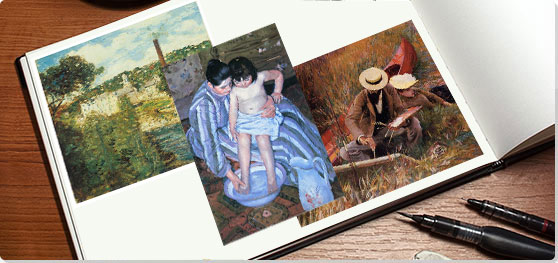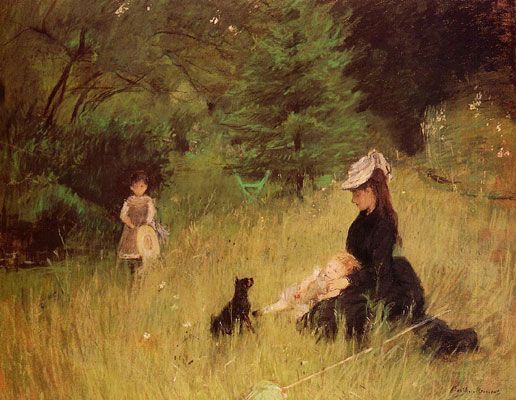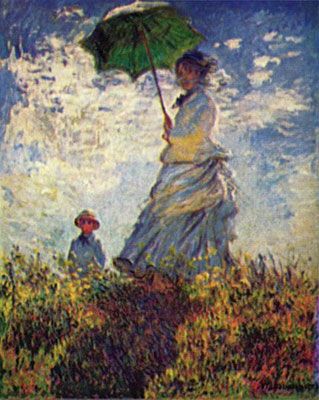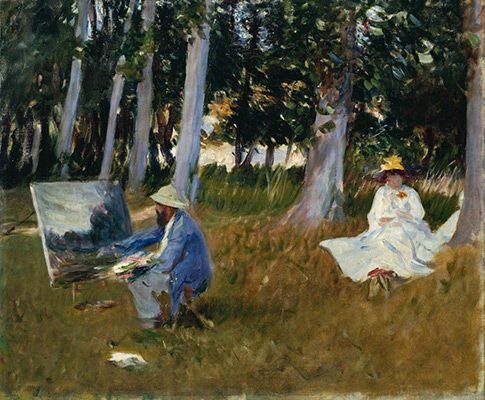Summary of American Impressionism
Like much of the art world, American painters of the late 19th-century were stunned and startled by the dazzling colors and vibrant brushwork of French Impressionism, yet by the century's end, Americans would be among the most passionate devotees of the Impressionist style. Inspired by the novel approaches to painting modern life embodied in French Impressionism, American Impressionism adopted bright palettes and loose brushstrokes to capture the intimate beauty of everyday American life. Whether capturing the natural world or urban energy, the American Impressionists broke with the traditional expectations of academic art to usher in the first popular, modern art movement in America.
Key Ideas & Accomplishments
- Although initially many American artists rejected the loose sketchiness of French Impressionism, their eventual adoption of the style ultimately facilitated a revolutionary break from the linear style and classical narratives that defined academic painting. In both style and subject matter, Impressionism inspired American painters to document their rapidly modernizing world with a mixture of curiosity and nostalgia.
- Combining European sophistication with identifiably American subject matter, American Impressionism quickly became popular among the increasing numbers of upper-class patrons. As American industrialists built private collections of art, they had previously purchased Old Master works to demonstrate their good taste; American Impressionists were the first contemporary artists to be widely collected by Americans.
- American Impressionism built upon the examples of landscape painting practiced by the Hudson River School and the Tonalists, particularly in the emphasis on immersion in the natural world and an attention to light and color. The Impressionist interest in everyday life and commonplace scenes, however, marked a difference from the transcendentalist visions of earlier 19th-century American landscape painting.
- The American Impressionists fostered new organizations for the creation and exhibition of their work; these innovations would last beyond the popularity of the style. Many of the artist colonies and exhibition societies that supported Impressionism were critical in broadening American art beyond academic painting.
Artworks and Artists of American Impressionism
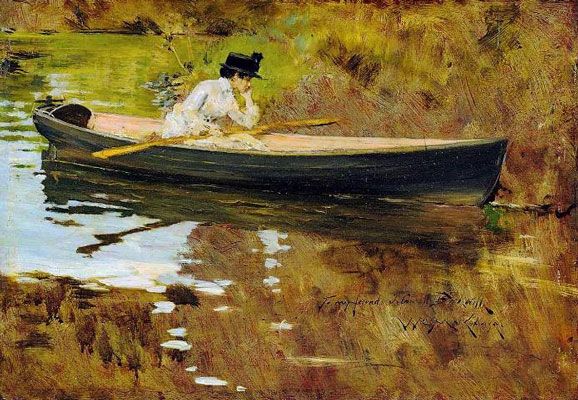
Mrs. Chase in Prospect Park
William Merritt Chase was one of the earliest American artists to incorporate Impressionism into his work. His series on the Prospect Park in Brooklyn, which he painted and exhibited in 1886, exemplifies his Impressionist style. Here, Chase depicts his future wife sitting in a row boat in a small lake. There is a sense of ease as she strikes a contemplative pose. The park offered a convenient spot to paint en plein air, following the example of the French. Furthermore, as a natural space engineered by people in the midst of an urban environment, the park provided the perfect backdrop for Chase's vision of upper class leisure and genteel interaction with light and nature. Prospect Park was also an answer to the sophisticated spaces of European capitals, arguing that American cities had evolved to include such cultural considerations.
The painting demonstrates the broad brushstrokes and interest in the play of light that are characteristic of Impressionist art, however, Chase's palette is notably more muted than most of French Impressionist painting. This might reflect his training in Munich (which he chose over studying in Paris). When he returned to America from Germany, he established an elaborately decorated studio in the Tenth Street Studio, the first building in New York designed as an artist space. He also began teaching at the newly formed Art Students League, making him a highly visible and influential central figure in American artistic circles. In the 1880s, he turned towards Impressionism, inspired by Whistler and Manet's loose brushwork along with a deep admiration for the work of John Singer Sargent, a lifelong friend after they met in 1881. His popularity among the social elite of Long Island, where he directed the Shinnecock Hills Summer School of Art helped to establish Impressionism as a collectable new school.
Oil on panel - The Metropolitan Museum of Art, New York
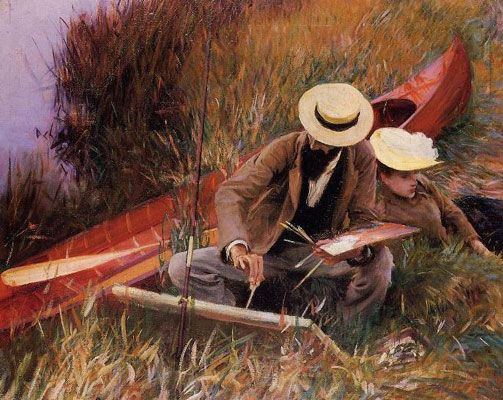
Paul Helleu Sketching with his Wife
John Singer Sargent was not a fully-fledged American Impressionist, but he had an important impact on the development of the movement as a conduit of new ideas from Paris to friends and colleagues in the states. His own style mixed elements of Impressionism with more traditional, academic portraiture. In this painting, Sargent depicts his friend, the French artist Paul Helleu, painting outdoors with his wife.
In this work, art critics Helene Barbara Weinberg, Doreen Bolger and David Park Curry argue that Sargent "revealed a great deal both about the practice and the purpose of the new movement in landscape painting as it would emerge in the United States. Landscape painting (not just the more common landscape drawing) has been brought outdoors, a point made forcefully by the artist's canvas shown resting directly on the ground, in the midst of the subject he is depicting, and by the presence of his brushes and portable palette. Sargent, already a well-known portraitist, depicts his model, an academically trained figure painter who usually works in the studio, embracing the plein air method and the commitment to direct observation that recently had become mainstays of his own work."
Sargent represents a seemingly unremarkable couple. The man paints professionally, but here he appears reclined in the grass, accompanied by his wife. Its ordinariness is key to its modernity, as Sargent rejects the need for a narrative. Without the title, the subject would only be recognizable to a small circle of friends and colleagues. The couple is viewed slightly from above, enclosing them in a natural space, but one that feels hospitable and comfortable. Sitting next to a small boat, they are day-trippers, enjoying a moment of leisure; their stylish clothing reveals that they are undoubtedly urban sophisticates, escaping to the fresh air of the countryside for a brief respite.
The viewer can't see what Helleu is painting; instead, the focus is on the figures and their immersion in nature. Notably, the couple's faces are detailed more carefully than the rest of the picture, creating a contrast with the looser brushwork of the grass and canoe. This speaks to Sargent's stylistic balance between academic and Impressionist approaches, which would influence other American artists.
Oil on canvas - Brooklyn Museum, New York
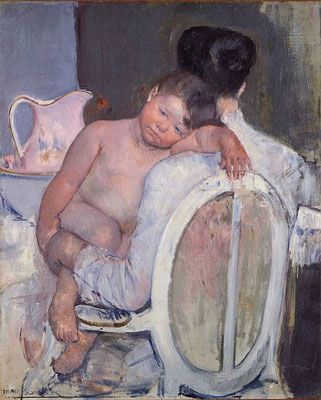
Woman Sitting with a Child in Her Arms
Although she developed her painterly style in tandem with artists such as Degas and Camille Pissarro, Cassatt's position as both a woman and an American positioned her as an outsider. While she was not quite as restricted by her gender as was her French-born colleague, Berthe Morisot, Cassatt tended to represent feminine subjects and domestic interiors. Unable to visit the racecourses, dance academies and cafes favored by her male counterparts, Cassatt painted the spaces and scenes she had easy access to among her acquaintances.
Although Cassatt spent two years at the Pennsylvania Academy of Fine Arts, her work was most influenced by her time in Europe. She studied academic art with Jean-Léon Gérôme in Paris during the 1860s, but when she returned to France in 1874, she became closely connected to the French group and showed her work with them on several occasions. Notably, Cassatt's work was also featured in the first major exhibition of French Impressionist work in the US, cementing her position as an artist who provided a bridge between French and American Impressionism.
Cassatt frequently painted images of mothers with their children, a subject that was often understood as a secular version of religious images featuring the Virgin Mary with the Christ child. Rather than monumentalizing her figures, however, Cassatt emphasizes the domestic qualities of each scene. Take, for example, the large expanse of the foreground that is occupied by the comfortable chair in which the mother sits. Although the room is actually fairly sparsely furnished, Cassatt's presentation of the chair and water pitcher create the impression of a comfortable bourgeois home, and particularly of a uniquely female space which is used to look after children. This painting is striking partly because the woman is looking away from the viewer. This both makes the woman anonymous and gives the impression that the mother and child inhabit a private and intimate space that cannot be shared by the viewer. Cassatt offered American Impressionists a model for painting calm scenes of domestic tranquillity, a key subject matter for the group.
Oil on canvas - Museo Bilbao, Spain
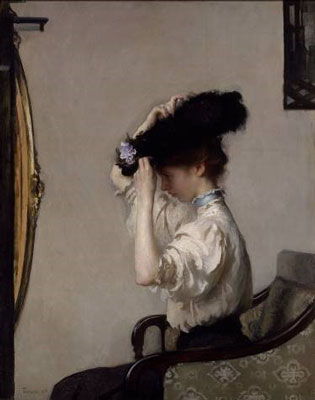
Preparing for the Matinee
A quiet image of simple domesticity, Tarbell captures a fashionable young woman preparing for an afternoon at the theatre. Although it appears to be a casual scene, Tarbell carefully arranged his paintings, often selecting precise accessories and furnishings that marked the space as specifically American. This young woman is unmistakably contemporary, as we can see from her clothing and hairstyle, yet Tarbell gives it a sense of timeless beauty through the glowing light and delicate palette of pastels.
Tarbell was active in Boston, where he was part of a circle of painters who combined Impressionism with more traditional styles of painting and finish. This work combines the looseness of Impressionism with his deep respect for the example of Jan Vermeer, a Dutch Baroque painter who specialized in warmly lit interior scenes. Vermeer's paintings often followed a compositional formula, featuring a hidden light source and close attention to texture, which we see Tarbell emulate. Indeed, the influence of Vermeer is made visible by the cropped quotation of one of his paintings, The Music Lesson, shown hanging in the upper right corner.
Oil on canvas - Indianapolis Museum of Art
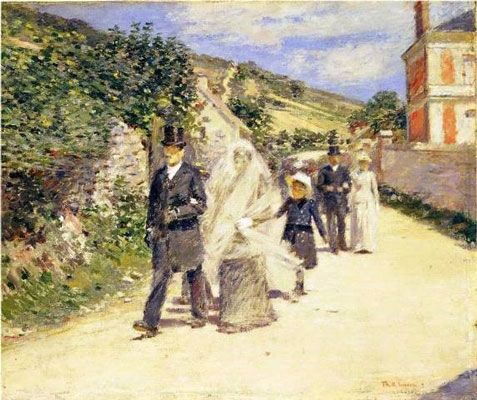
The Wedding March
A group of American artists settled in the small village of Giverny, painting the landscapes around Monet's home (despite the French artist's reluctance to take on students). Of these, Robinson was one of the few painters on cordial terms with Monet, particularly at this moment. The art historian William H. Gerdts has argued that "The Wedding March testifies to Robinson's enduring closeness to Monet and his family. Monet continued to critique works Robinson showed him, and Robinson adopted some of Monet's subjects. The high point of this interchange occurred in 1892, when Monet asked Robinson's opinion on some of his first views of Rouen Cathedral." Monet was less welcoming to other Americans living in Giverny, worried about them copying his work or trying to seduce his stepdaughters. (The latter fears were perhaps justified when his stepdaughter Suzanne Hoschede-Monet married the American painter Theodore Butler in 1892.)
Two weeks after that wedding, Robinson began painting this scene. It is a work that speaks to the strong influence of Monet both on his own work and on American Impressionism in general. Although the title The Wedding March might suggest a formal ceremony, the couple are depicted casually strolling down a village street. There is no pomp, just a natural image of people's lives. Still, the stylish formal dress of the two couples belies their sophisticated backgrounds; they are not simply villagers, but members of the upper-class.
While certainly Robinson adopts the loose brushstroke of Impressionism, the greatest influence of Monet is in his treatment of the brilliant sunlight. With the sun nearly directly overhead, even the dark suits of the gentlemen and the shadows they cast are shades of purples and blues. The brightness both calls our attention to the translucent veil on Suzanne and blinds us to her face.
Oil on canvas - Terra Museum of American Art, Evanston, Illinois

The Red Bridge
When J. Alden Weir visited an 1877 exhibition of Impressionist painting, he was originally repulsed, commenting that it was "worse than the Chamber of Horrors." In time, however, he came to embrace the style. This painting captures many themes of French Impressionism, including the juxtaposition of new industrial structures with bucolic nature. The new bridge, painted a brilliant red, is mirrored in the running water below to create a doubling effect. Weir was rare among the American Impressionists in showing an interest in industrialization. While many of his colleagues chose to feature carefully crafted spaces of leisure and beauty, such as parks and gardens, to give their works a sense of nostalgic distance, Weir's treatment of these modernizing elements aestheticizes them as part of an exciting, evolving national landscape.
Weir uses the powerful red tone of the bridge to contrast the structure's industrial geometric structure with the softer organic curves that surround it. Combining opposites to achieve a sense of harmony, Weir reveals the influence of Japanese woodblock prints. Japanese art had been critical to the development of Impressionism and Weir was perhaps the most astute American interpreter of this influence. The compositional space is flattened by the high horizon and the cropping, which reduces some of the trees and branches to geometric fragments. This creates a more daring modernist arrangement, one that approaches abstraction in the water's reflection.
Oil on canvas - The Metropolitan Museum of Art, New York
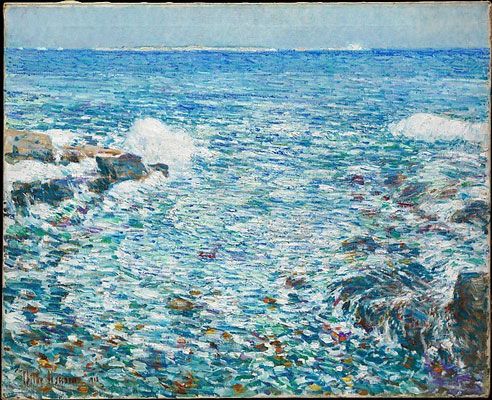
Surf, Isles of Shoals
Painted in the year of the Armory Show, which introduced 20th-century modernism to American audiences, this painting is evidence of the continued life of American Impressionism into the 20th century. Far from its radical roots, it became a style associated with genteel calm and upper-class patrons, particularly as executed by Childe Hassam.
Deeply influenced by Monet and his 1880s paintings of the northern coast of France, Hassam depicts a stretch of tumultuous, churning water and rocky coast. It was a distant cry from his city scenes and quiet interiors, yet this escape into the wilderness has been aestheticized through pleasant contrasts of oranges and purples and delicate brushwork. The site was deeply familiar to the artist; Hassam produced approximately 10% of his works at the Isles of Shoals, an artist colony off the coasts of Maine and New Hampshire.
Like other Impressionists, Hassam was influenced by Japanese woodblock prints, as can be seen in the high horizon line and flattened pictorial depth. The interwoven brushstroke adds another level of flatness, emphasizing the two-dimensionality of the canvas; the result inches towards the abstract canvases of emerging modernist movements. Hassam sits at the intersection of two centuries: the inheritor of 19th-century Impressionist experiments with color and light, and the 20th-century abstractionists who began to liberate these formal qualities from concrete subject matter.
Oil on canvas - The Metropolitan Museum of Art, New York
Beginnings of American Impressionism
A New Era for American Art
With the end of the Civil War and a new era of American prosperity, the wealthy built large houses to showcase their success. In order to demonstrate their cosmopolitan taste, they furnished these mansions with furniture and art imported from Europe. Although American artists such as the Hudson River School and the Tonalists had developed distinctively national styles, their paintings did not command the prices of European art; American art was not considered fashionable or sophisticated. To become a respected artist, it was necessary for Americans to train in the famous art schools of London and Paris and adopt the academic styles taught there.
The French Impressionists
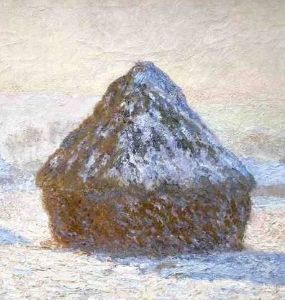
By the 1870s, however, academicism was being threatened by the emerging avant-garde, particularly in France. The Impressionist group first showed together in 1874. Although their styles and intentions were diverse, the Impressionists were united in rejecting the traditional Parisian Salon and its stale academic tradition. In general, an Impressionists' aesthetic emerged that was notable for the use of loose brushwork and experimental color composition, with a new focus on the effects of light. Furthermore, the Impressionists were interested in these optical effects rather than narratives; they privileged scenes of everyday life and natural beauty over the highbrow subjects of traditional painting.
American Impressionists Emerge
Interestingly, both visiting American artists and the buying public in the US rejected Impressionism, even as the style gained critical attention from French critics. The Americans, who had been indoctrinated in the tenets of academic art found Impressionism too radical in its rejection of fine art. For much of the 1870s and 1880s, American artists in Europe followed more traditional styles of painting, which remained popular (and salable) at home. These decades saw the beginnings of an active art market in the U.S., where an increased number of art dealers began showing works by American artists and established names from Europe. The market favored artists who offered an American version of European painting trends, blending a certain nationalism and cosmopolitanism. During these years, a number of art magazines and periodicals were established, allowing both connoisseurs and amateurs to follow artist developments at home and abroad.
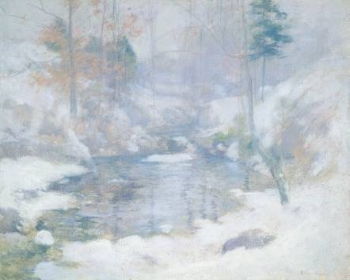
In time, the American hesitancy about Impressionism began to soften, particularly as viewers became more accustomed to the abstractions of the style. A few intrepid American artists were among the first foreigners to embrace the innovations of French Impressionism (notably Mary Cassatt, John Singer Sargent, and James Abbott McNeill Whistler) and their works became popular back home. Then, as works by the French Impressionists arrived in the U.S., they found support within a small group of Americans who became the first major purchasers of the style.
American Artists in Europe
While most American artists initially rejected the Impressionist style, there were a few key exceptions. Whistler and Sargent found in Impressionism an approach similar to their own explorations of color and everyday subject matter. American born, Whistler spent most of his career in London, but he maintained strong connections with Paris, where he had trained. He was even invited by Edgar Degas to exhibit his work with the first French Impressionist exhibition of 1874, (an offer Whistler refused). Whistler had several important patrons and influential acquaintances in the United States, including the painter William Merritt Chase. Sargent, another American who trained in Paris and lived in London, was also a conduit for Impressionism to reach American audiences. Sargent made several professional trips to the US, where he painted a number of well-received portraits and works in the Impressionist style.

Since neither Whistler nor Sargent fully embraced the Impressionist movement, preferring to maintain their independence, Mary Cassatt became the first and most notable American Impressionist, helping to popularize the style. Born in Pennsylvania, she moved to Paris in 1866 where she became firmly embedded in the Impressionist movement in Europe and was most closely associated with Degas. She exhibited her work with the Impressionist group several times and remained in France until her death in 1926. The sale of her paintings to American clients did much to create the demand for Impressionist works in the U.S.
Impressionism Accepted
Impressionism became more fashionable in America during the 1880s, as many artists adopted its aesthetic and subject matter. Many American artists lived cosmopolitan lives, traveling to Europe frequently to see exhibitions and discover new techniques and trends. Also important was the influential art dealer Paul Durand-Ruel who befriended Claude Monet and had championed the Impressionists for many years. Having previously exported Impressionism to London, where his gallery expanded in 1870, he organized the first exhibition of Impressionist art in the U.S. in 1883, sending works by Manet, Monet, Renoir and Pissarro to Boston. Seeing the growing American market of art collectors, in 1886, Durand-Ruel organized a similar but larger show in New York City. That show caused a sensation, prompting artists, collectors and critic to reconsider their initial opposition to the style.
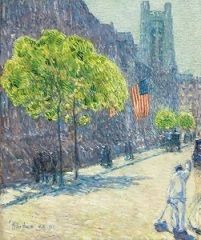
Impressionism quickly became a popular style, its varied aesthetic allowing American artists to experiment with the principles of the movement and adapt it for American subjects and audiences. Artists such as William Merritt Chase, Edmund C Tarbell and Childe Hassam painted parks, gardens and the countryside around New York and Boston, adding a recognizably American sensibility to the European style.
Artists' Colonies in the Northeast
During the 1890s, a number of artists' colonies were established; American Impressionism flourished in these bohemian enclaves. Working in these collaborative villages, artists learned from each other and shared ideas and resources. They were often established in areas of great natural beauty, but within an easy journey of a large city where work could be exhibited and sold.
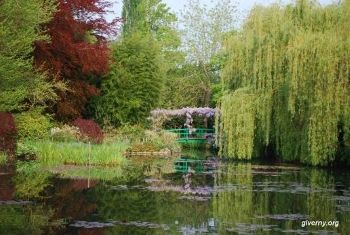
Notable groups of artists gathered at New Hope, Pennsylvania, and at Cos Cob and Old Lyme in Connecticut, as well as on New York's Long Island. On the other side of the United States, American Impressionist artists also worked at Carmel and Laguna Beach in California. Many of these colonies were inspired by Monet's famous garden and studio at Giverny in France, which had become a pilgrimage site for many American artists. Sometimes, wealthy patrons and collectors invited artists to their country homes, resulting in smaller-scale groups, such as the Blaney family who played host to Childe Hassam, John Singer Sargent, and John Leslie Breck at Ironbound Island in Maine.
The Ten American Painters
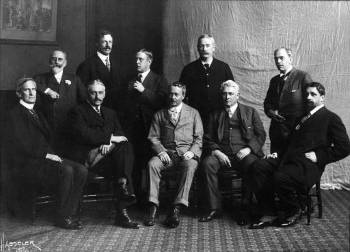
American Impressionism was first organized into a movement with the formation of "The Ten," a group of painters who opposed the more traditional Society of American Artists. In January 1898, they announced their resignations from the society, following the French Impressionists' rejection of the official Salon. The group consisted of Childe Hassam, J. Alden Weir, John Twatchman, Robert Reid, Willard Metcalf, Frank W. Benson, Edmund C. Tarbell, Thomas W. Dewing, Joseph R. De Camp, and Edward Simmons. William Merritt Chase also joined the group some years later. Although some of these artists were less notable, and some key American Impressionist artists (such as those living in Europe) were excluded, the group provided a centralizing locus for American Impressionism as a movement.
American Impressionism: Concepts, Styles, and Trends
American Nature
The intention of French Impressionism was to capture a fleeting snapshot, or a representation of the artist's perception of a place rather than an accurate study. The Impressionists didn't choose overly romantic or fantastical locations for their paintings, but instead focused on everyday spaces, such as cities, gardens, and places of popular entertainment.
When Impressionism came to America, artists were similarly interested in capturing fleeting impressions and in depicting scenes of everyday life. However, they were also interested in something beyond the aims of their French counterparts, which was capturing places that offered a sense of national identity. For many artists, such as Childe Hassam, painting scenes of American nature offered a chance to differentiate their work from European Impressionism. It also provided continuity from the Hudson River School, which had celebrated the American landscape as a point of national pride and glory. By depicting the natural wonders of the country, especially those found around some of the artist colonies established in the 1880s, American painters developed a patriotic Impressionism.
Returning Home
Interiors and domesticity were key themes for many American Impressionists, as they were for their French counterparts (notably Berthe Morisot and Edgar Degas). Patrons embraced the colorful and harmonious images of domestic tranquility, often as an antidote to the harsher realities of industrial and urban life. Mary Cassatt's paintings of intimate interiors and female companionship inspired American Impressionists of both genders. The paintings of Edmund Tarbell demonstrate the influence of these examples of quiet domesticity and the beauty of simple scenes from everyday life.
Gardens and parks
Like their French predecessors, many American Impressionists painted scenes set in gardens and parks. However, whereas Monet's garden paintings were often based on the vibrant colors and unusual compositions they offered (privileging form and color over subject matter), many Americans were more deeply inspired by the example of Renoir, who focused on the changing social interactions that took place in these spaces. In the work of Edmund Tarbell or William Merritt Chase, for example, these spaces offered a backdrop for women at leisure, enjoying nature in a controlled and safe environment. An extension of the beautiful interiors and domestic representations of the home, gardens and parks were carefully curated to provide a setting of luxuriant calm and tranquility.
Later Developments - After American Impressionism
After a meteoric rise in popularity and prestige, American Impressionism quickly replaced academic art as a favorite of collectors. Its soaring prestige, however, was quickly halted by the 1913 Armory Show, which featured more experimental art from Europe (including the Fauves and Cubists) and America (including the abstractions of the Stieglitz circle of artists and the realism of the Ashcan School). For many collectors of modern and contemporary art, American Impressionism became outdated and conservative.
Yet, despite its fall from the avant-garde, many artist colonies where American Impressionism had flourished continued to be key centers into the 1920s. Many artists, such as Childe Hassam and William Merritt Chase continued to work in the style, patronized by an older market which demanded more visually pleasing works rather than the conceptual avant-garde styles.
Useful Resources on American Impressionism
- American Impressionism (2001)Our PickBy William H. Gerdts / Comprehensive picture-based compilation of works in this style
- American Impressionist Masterpieces (1991)Our PickBy Lisa N. Peters / Catalogue of famed American Impressionist works
- Theory and Investigation American Impressionism and Realism: The Painting of Modern Life, 1885-1915 (1994)By Helene Barbara Weinberg, Doreen Bolger, David Park Curry
- Impressionism in America: The Ten American Painters (1991)By Ulrich W. Hiesinger
